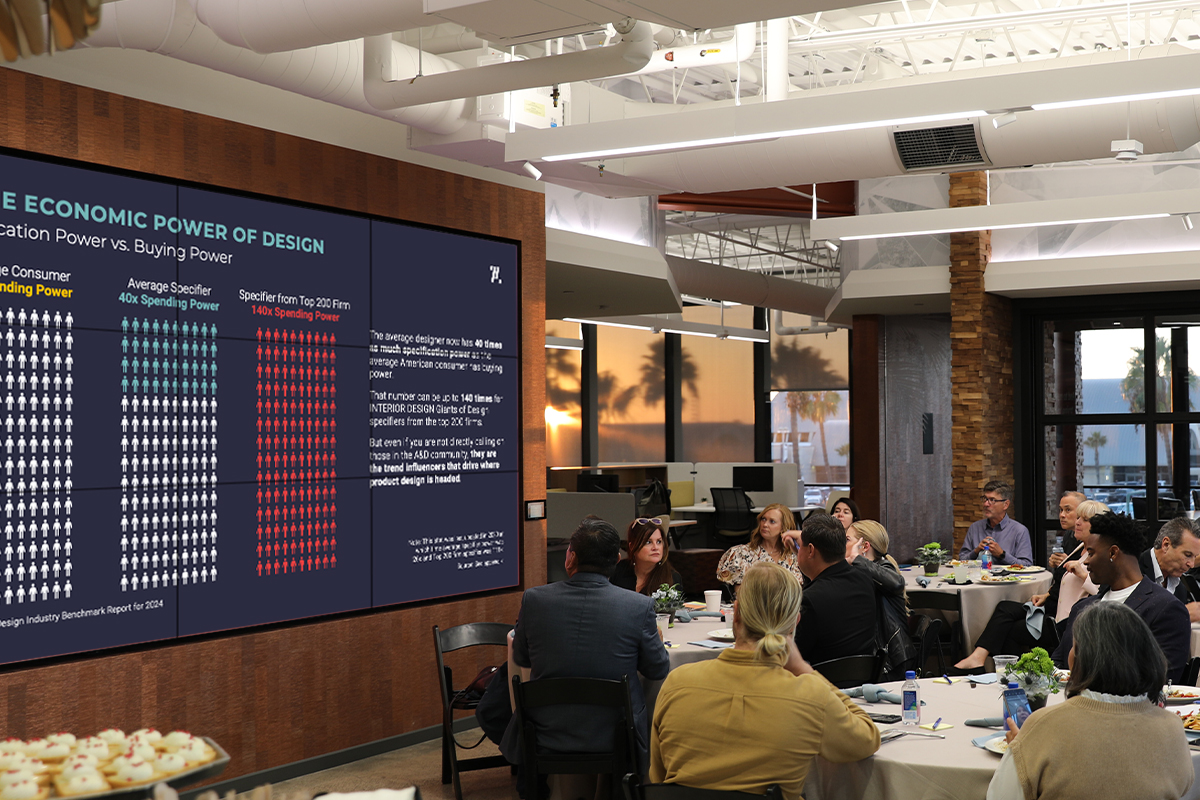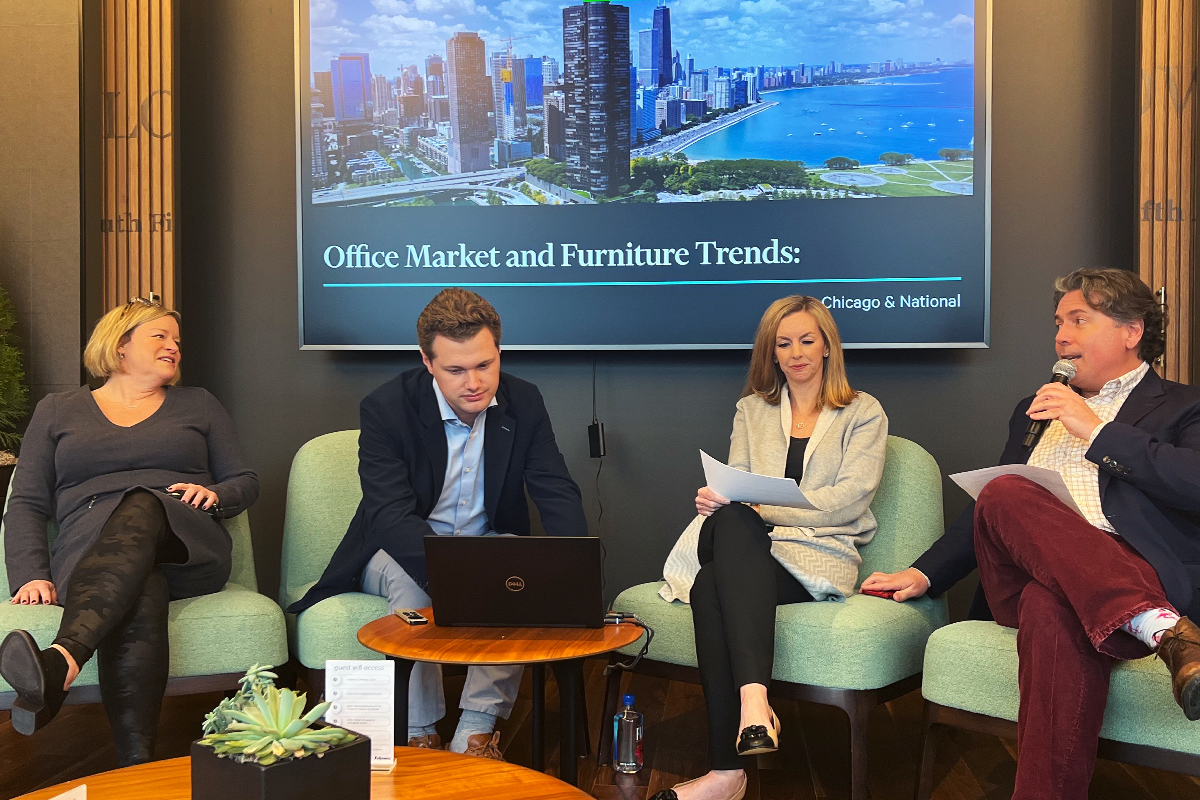
During a recent panel at the Association for Contract Textiles’ annual Interact Conference on the leading disrupters affecting the interiors industry, attendees heard firsthand from esteemed designers the behind-the-scenes tidbits they wish distributor and manufacturer reps knew. The panel included Lance Amato from Vocon, Irina Sai from HOK, and Lauren Shaw from WeWork. While the topics covered opinions on product and process innovation, perhaps nothing enlightened the audience more than when the conversation shifted to the ways in which dealers and manufacturers could best support designers.
“I feel like the biggest point I took away from the discussion was the disconnection between the specifiers and the people who produce and sell the products,” shares Sai, a senior interior designer and senior associate at HOK.
Across the board, the panel felt that the way we specify today is changing, and more than fancy design tools and expensive lunch and learns, designers crave a simplified communication stream. And their plea for simplicity came with bold comments that the audience was—dare we say—surprised to hear.
As the only millennial on the panel, Shaw from WeWork received the bulk of the inquisitive feedback. Reflecting on the panel, Shaw recalls that her impressions were mixed: “I was surprised that they were shocked to hear what we had to say. As designers, it can be a little bit awkward to give this kind of feedback to people when this is their livelihood, but simply put, the way they are doing it isn’t always the best way to reach us.”
So what shifts in process were revealed?
Connect with me on my terms
It wasn't long before the conversation began to take a turn. Shaw expressed how she likes to work with vendors, and at first, her comments were rather expected: “I am drawn to vendors that have really well-done websites with great imagery, downloadable tear sheets, and great specs,” she said. But then she continued, “I use reps as a secondary resource. I don’t like calling on the phone and prefer email communications because I can get to email when I have time.”
And while the gut reaction to this comment may be to attribute it to the millennial mind-set, Sai, a senior-level designer, echoed Shaw’s comments when later reflecting on the panel. “When we talk about generational differences, senior designers and principles are becoming more generalists and don’t have an hour to spend just looking at fabrics,” she explains. “So that goes to a junior designer or a furniture dealer. At the same time, clients are asking us to do the same design in half the time. So we make shifts that work for our way of managing our existing workloads.”
Shaw, also reflecting on the panel, adds that in addition to a greater understanding surrounding designers’ time management she feels that many reps can benefit from a better awareness of designers’ needs. “I think that reps don’t understand that with younger designers we don’t have time to do lunch and learns or sit and look at everything in your catalogue. Too many reps are focused on sales and not on listening to our needs. For example, there are a lot of commercial products that we wouldn’t use at WeWork because they are either not on brand or in our budget. Yet many reps have walked in and tried to show us these products. To me, that’s a red flag that they aren’t there to support us; they are there to sell. I like working with vendors that act like they are my teammate. The vendors I work with the most have the social awareness to accomplish both their sales goals and my design needs in one meeting.”
I don’t care about double rub ratings. Tell me what happens when you spill coffee on it.
Another bold conversation topic came in the form of industry standards. Across the board, the panel agreed that industry standards are put in place for a reason and that with them the industry thrives. But they also were in agreement that the way in which we communicate these standards needs to evolve.
Sai recalls the topic of technical aspects of fabrics fondly. As she puts it, “Attendees were asking questions about the products and how we know how durable they are—considering things like fading, functionality, how it’s used, etc. The biggest point is that maybe we don’t need to know all of that. We don’t need to decipher it all. We need to know if I spill coffee on it, will I be able to wipe it off? Reps need to be able to simplify how we use this information to compare one product to another.”
She explains that this principle of simplification stems back to her idea of designers becoming more of generalists. She continues, “Maybe before it was okay for a designer to hear all of these technical specifications, but now the biggest reason that designers want to work with the company is their brand. We want to partner with people who think and communicate the same as we do and who have the same worldview regarding the responsibility of design. I think the first step is to simplify the ratings through transparency.”
Sai is quick to reinforce that she doesn’t want specification standards to disappear but instead suggests that the way in which they are communicated to designers—and clients—at first blush, should be simplified. That said, she reaffirms that the technical ratings are still very important and should be available to the designer who wants to dig deeper.
Bringing the topic full circle, Shaw shares this story: “We had a dinner the night before the panel, and there was much discussion around the topic of fabric standards. I think that people of all generations need to be most effective with their time and simply can’t be an expert on everything. We live in a world where we have to work faster but can’t give up quality. So we need to adapt to make our workload manageable.”
When time becomes the commodity we most desire, making the most of it can be the difference between a good rep and a great one. So, as the panel concluded, the leading takeaways were to understand your audience, including their communication preferences and product needs (such as design style), and to simplify the way in which product information is shared with them.
As an insightful look into the future relationship between designers and reps, Sai leaves us with this: “I think first and foremost we need to have passion for what we do—be it designers curating an expertly appointed space or a rep delivering a stellar sales pitch. And when we pair that passion with a keen amount of respect for our industry counterparts, everything else will follow.”
This article originally was published in Bellow Press and was reposted here with permissions.
Amanda Schneider is President of ThinkLab, the research division of Interior Design Media. At ThinkLab, we combine Interior Design Media’s incredible reach within the architecture and design community with proven market research techniques to uncover relevant trends and opportunities that connect back to brand and business goals in a thought-provoking, creative, and actionable way. Join in to know what’s next at thinklab.design/join-in.


.jpg)